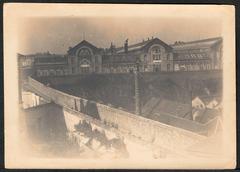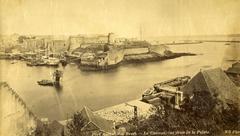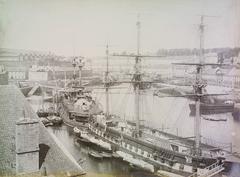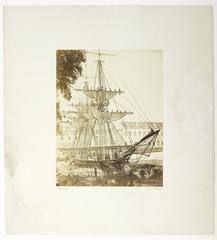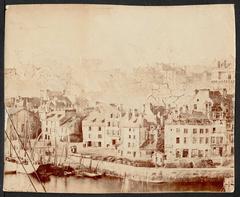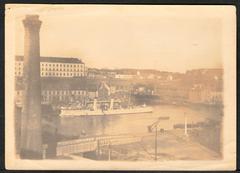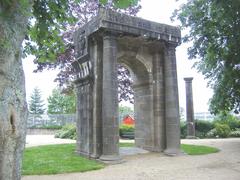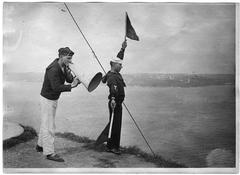Visiting Hours and Tickets for Monument À Jean Cras in Brest, France
Date: 14/06/2025
Introduction
The Monument À Jean Cras, located on the scenic Cours Dajot promenade in Brest, France, stands as a powerful tribute to Jean Émile Paul Cras (1879–1932). Cras was a distinguished rear admiral in the French Navy, an innovative inventor, and a celebrated composer. The monument, overlooking the Penfeld River and Brest’s bustling harbor, honors his remarkable legacy—one that continues to resonate through both maritime technology and music. This guide provides comprehensive information for visitors, including historical context, architectural details, practical visitor tips, and links to official resources.
For further details and updates, refer to the Brest Tourism Website and the École Navale Traditions.
Table of Contents
- The Legacy of Jean Cras: A Dual Tribute
- History and Significance of the Monument
- Artistic and Architectural Features
- Visiting Information: Hours, Tickets & Accessibility
- How to Get There
- Nearby Attractions
- Visitor Experience and Tips
- Special Events and Guided Tours
- Frequently Asked Questions (FAQ)
- Enhance Your Visit: Digital Resources
- Summary and Key Visitor Tips
- References
The Legacy of Jean Cras: A Dual Tribute
Jean Cras was born in Brest and became one of its most illustrious figures. He rose to the rank of rear admiral and revolutionized maritime navigation with his invention, the “Règle Cras,” a tool still used by navigators today. Cras’s parallel career as a composer brought him national acclaim, with works that drew inspiration from both Breton culture and the sea (Wikipedia). The monument celebrates this unique blend of naval innovation and artistic creativity, making it a site of both local pride and national significance.
History and Significance of the Monument
The original Monument À Jean Cras was inaugurated in 1935, three years after Cras’s death, and was designed by the renowned sculptor Raymond Delamarre in a striking Art Deco style (École Navale Traditions). The monument was destroyed during World War II but was faithfully reconstructed and reinstalled in 1959, demonstrating the city’s commitment to preserving its cultural heritage (actu.fr).
The monument’s location on the Cours Dajot is symbolic, offering panoramic views of the Rade de Brest and connecting Cras’s story to the city’s maritime identity. Its presence is central to commemorative events and heritage walks that highlight Brest’s naval and cultural history (wiki-brest.net).
Artistic and Architectural Features
Design and Symbolism
- Sculptor: Raymond Delamarre
- Style: Art Deco, with clean lines and stylized form (École Navale Traditions)
- Materials: Resilient local granite and bronze
Key Elements
- Allegorical Figures: Two allegories—one representing the Navy, holding a caravel, and one representing Music, holding a violin—symbolize Cras’s dual legacy (musimem.com).
- Inscriptions: The monument features Cras’s name, dates, military rank, and honors, as well as references to his invention.
- Orientation: The monument faces the harbor, symbolizing Cras’s life at sea.
- Physical Presence: Approximately 3–4 meters high, it commands attention on the Cours Dajot.
Setting
The monument stands amidst landscaped gardens, mature trees, and open lawns, creating a tranquil environment for reflection and appreciation (Petit Futé).
Visiting Information: Hours, Tickets & Accessibility
- Hours: Open 24/7, as it is located in a public outdoor space.
- Admission: Free; no tickets or reservations required.
- Accessibility: Wheelchair accessible, with paved paths and gentle slopes along the Cours Dajot.
- Location: Place du Général de Gaulle, western end of Cours Dajot, Brest.
- Nearby Facilities: Public restrooms, benches, cafés, and restaurants are within a short walk.
How to Get There
- On Foot: The monument is within walking distance from Brest’s city center and major attractions.
- Public Transport: Several bus lines stop nearby; check local schedules for the latest routes.
- By Car: Parking is available in the vicinity, though it may be limited during peak times or large events (mappy.com).
Nearby Attractions
- Château de Brest: A historic fortress and the Musée National de la Marine.
- Jardin des Explorateurs: A scenic park nearby.
- Rue Saint-Malo: One of Brest’s oldest surviving streets.
- Brest Harbor: Offers vibrant maritime activity and views.
Combine your visit to the monument with these sites for a fuller experience of Brest’s heritage (The Crazy Tourist).
Visitor Experience and Tips
- Best Time to Visit: Spring and summer provide pleasant weather and long daylight hours. Early morning and late afternoon offer the best natural light for photography.
- Events: The monument serves as a focal point during commemorative ceremonies and the Fêtes Maritimes de Brest, offering excellent vantage points for viewing maritime festivities.
- Safety: The area is safe and well-frequented, but exercise normal caution after dark.
Special Events and Guided Tours
- Guided Walks: Brest’s Patrimoines service and local tour operators offer heritage walks that include the monument, focusing on naval and cultural history.
- Commemorations: Annual ceremonies with musical performances and speeches by local dignitaries highlight the monument’s ongoing cultural significance (actu.fr).
Frequently Asked Questions (FAQ)
Q: What are the visiting hours?
A: The monument is accessible 24/7 as it is in a public space.
Q: Is there an entry fee or ticket required?
A: No, admission is free.
Q: Are guided tours available?
A: Yes, guided heritage walks including the monument are offered by the city’s tourism services; check the official tourism site for details.
Q: Is the site accessible for wheelchair users?
A: Yes, the monument and Cours Dajot are wheelchair accessible.
Q: What are other attractions nearby?
A: The Château de Brest, National Maritime Museum, Jardin des Explorateurs, and historic waterfront areas.
Enhance Your Visit: Digital Resources
- Audiala App: Download for curated audio guides and interactive walking tours of Brest’s historical landmarks.
- Official Websites: Check the Brest Tourism Website and École Navale Traditions for maps, event updates, and virtual tours.
Summary and Key Visitor Tips
The Monument À Jean Cras epitomizes Brest’s enduring maritime tradition and cultural spirit. Its prominent location, symbolic design, and free, round-the-clock access make it a must-see for visitors interested in French naval history and the arts. The monument’s proximity to other historical sites allows for a rich, immersive exploration of Brest’s heritage.
- Location: Cours Dajot, Brest, France (Google Maps)
- Admission: Free, always open
- Accessibility: Wheelchair accessible
- Nearby Attractions: Château de Brest, National Maritime Museum, Jardin des Explorateurs
To fully appreciate the site, plan your visit during daylight, explore nearby landmarks, and take advantage of digital tools like the Audiala app for deeper insights.
References
- Petit Futé – Brest Tourism Overview
- Brest Metropole Tourisme – Official Brest Tourism Website
- École Navale Traditions – Jean Cras Biography and Monument
- Musimem – Jean Cras Composer Profile
- Actu.fr – Brest’s Commemoration of Jean Cras
- The Crazy Tourist – Things to Do in Brest
- Wikipedia – Jean Cras
- Wiki-Brest – Jean Cras
- Mappy – Location Map
Experience the legacy of Jean Cras and discover the maritime and cultural heart of Brest by planning your visit to this remarkable monument.

